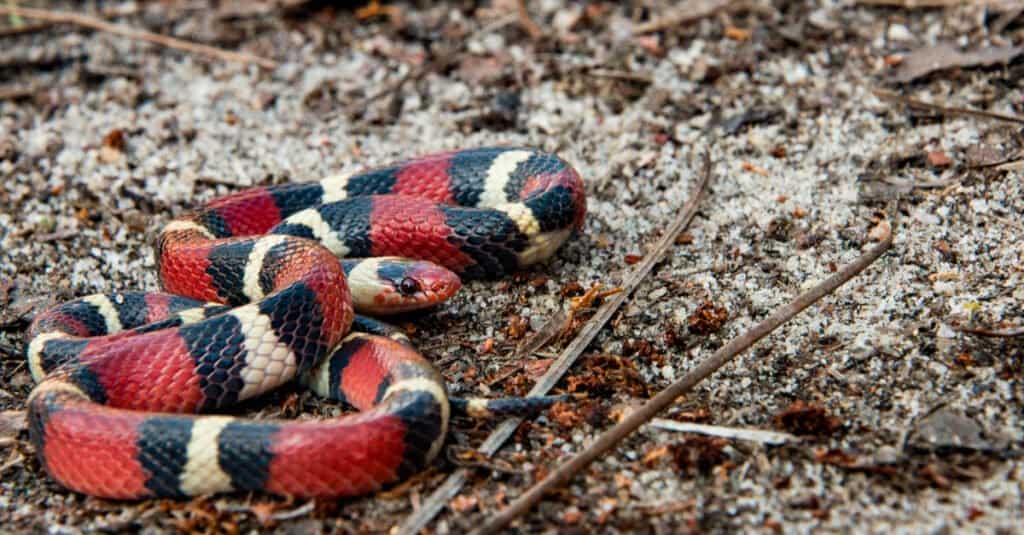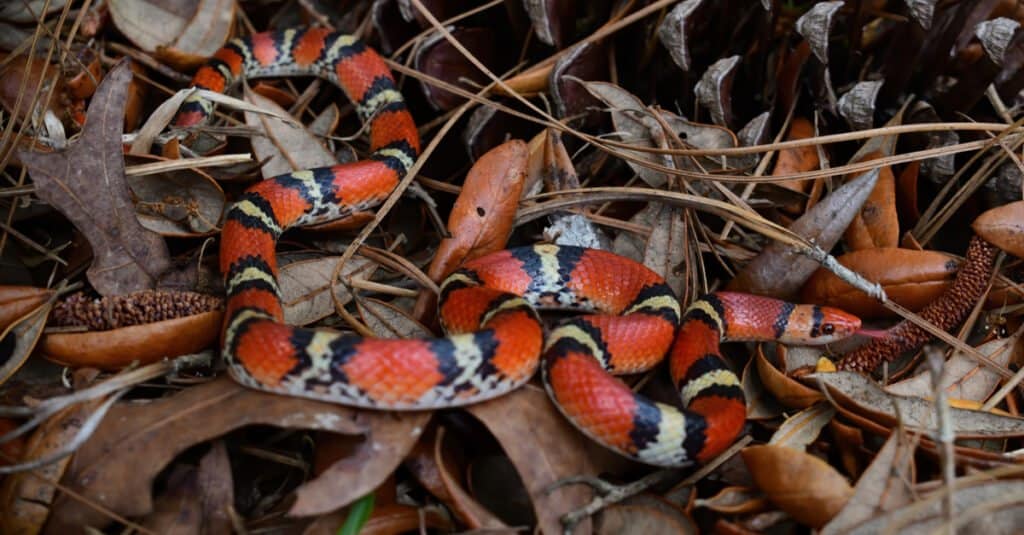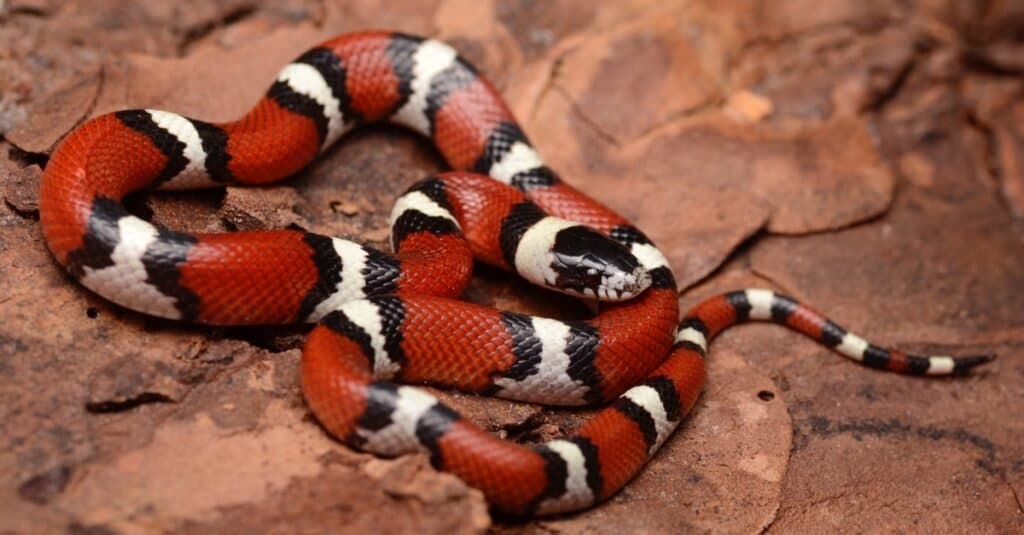Key Points:
- Coral snakes are classified as Old World (belonging to Asia) or New World (belonging to the Americas). Both Old and New World coral snakes are related to cobras and are some of the most dangerous snakes in the world.
- Two distinguishing characteristics of coral snakes are that North American coral snakes have small heads and black snouts (their mimics usually have red heads), and their scales have a pattern of repeating bands of thick black band, thin yellow band, and thick red band.
- Old World coral snakes have more color variation and do not stay true to the red, yellow, and black pattern.
- In North America, the coral snake has several mimics that are not actually coral snakes, such as the corn snake, scarlet kingsnake, and Florida scarlet snake.
Florida is home to an astonishing variety of snakes, most of them totally harmless. Still, there are a few snakes in the state that are quite dangerous and potentially deadly. Of all of the venomous ones, none is more secretive than the coral snake in Florida.
Although its name may deceive you, this snake doesn’t dwell in the ocean. Today, we are going to be learning to identify coral snakes in Florida and learn a little about their mimics.

What Is a Coral Snake?

Coral snakes are some of the most venomous snakes in the U.S., but they are rarely ever seen.
©Jay Ondreicka/Shutterstock.com
Coral snakes belonging to the Micrurinae subfamily are native to the Americas and are classified as some of the most dangerous New World snakes around. All coral snakes (New and Old World) belong to the Elapidae family and are related to cobras. There are 84 recognized species of New World coral snakes, all of which are venomous.
The lifespan of coral snakes is a little tricky because they are very reclusive. However, in captivity, they can live up to around 10 years of age, which is understandable because reptiles have a longer lifespan on average than mammals of the same size.
Although there are many species of coral snakes, most of them live in Central and South America. Additionally, coral snakes are extremely elusive and spend most of their time hidden underground and in the brush.
The likelihood of running into a coral snake is extremely rare, and most people usually sight their mimics thinking they saw one. Luckily, coral snakes, even when confronted, rarely bite. They are extremely passive creatures and don’t bite unless seriously provoked.
There is one true coral snake in Florida, with a secondary subspecies that can be found in some regions. Let’s learn how to identify them.
Coral Snakes in Florida
Eastern Coral Snake (Micrurus fulvius)

The
eastern coral snake
has a unique banding pattern that warns off predators.
©iStock.com/JasonOndreicka
The only coral snake species that lives across the southeastern United States is known as the eastern coral snake. The eastern coral snake is a slender, medium-length snake that rarely grows past 30 inches in length.
Identification: The best way to identify a coral snake is through its unique coloring. Eastern coral snakes have a pattern of banding that goes from their head to their tails. The pattern has repeating bands that go: thick black band, thin yellow band, and thick red band. There is a famous mnemonic that reads: “red touch yellow, kill a fellow,” and this is true only for North American coral snakes. Eastern coral snakes never have bands of red touching bands of black, but they occasionally have small spots or faded blotches of black on their red bands. Another “tell” for coral snakes is their inky black head, as most mimics have red heads.
Distribution: The eastern coral snake can be found across the entire state of Florida and lives from North Carolina all the way through Florida and west through Louisiana.
South Florida Coral Snake (M. fulvius barbouri)
Although the eastern coral snake is the only recognized species of coral snake in Florida, there is an occasionally recognized subspecies called the south Florida coral snake. There is little information on what differentiates a South Florida coral snake from an eastern coral snake, although a few scientific papers cite this subspecies specifically.
Commonly Misidentified As Coral Snakes
These are a few of the snakes that look nearly identical to the eastern coral snake and can be easily misidentified. In order to recognize a true coral snake in Florida, we need to be able to differentiate these look-alikes from it.
Scarlet Kingsnake

The red-on-black of the scarlet kingsnakes allows for easy identification.
©Jay Ondreicka/Shutterstock.com
The scarlet kingsnake is a coral snake mimic that can be found across the entire state of Florida and even into the Keys. They belong to the Lampropeltis family and are classified as kingsnakes, although some people refer to them as milk snakes.
These snakes are generally more vibrant in color than coral snakes, although they have the same exact colors across their body. The best way to tell the difference between scarlet kingsnakes and coral snakes is the pattern of the banding and the head.
Scarlet kingsnakes have a banding pattern that goes: thick red, thin black, thin yellow, and then repeats. The key is that the black and red bands are touching, whereas the coral snake bands don’t. Additionally, the heads of scarlet kingsnakes are usually tipped in red, whereas coral snakes are black.
Florida Scarlet Snake

Scarlet snakes have incomplete bands and white bellies.
©Chase D’animulls/Shutterstock.com
The Florida scarlet snake (often called the scarlet snake) is another coral snake mimic that can be found across the state of Florida, save the Keys. They belong to the Cemophora family and are not kingsnakes or milksnakes, which they are often misidentified as.
The best way to identify a scarlet snake is its coloration. They have an identical band pattern to the scarlet kingsnake, but instead of yellow, their coloration is more whitish or cream. The best “tell” for a scarlet snake is its banding completion and belly coloration.
Whereas coral snakes and scarlet kingsnakes have banding that wraps around their body, the scarlet snake has a white body, and the bands end near their sides. Additionally, their bellies often have a checkerboard white and black pattern.
Corn Snake

Corn snakes are red and orange but they don’t have any banding like coral snakes.
©Enrique Ramos/Shutterstock.com
The corn snake is a rat snake that belongs to the Pantherophis genus. They are closely related to the eastern and gray rat snake but have a distinct coloration and are commonly kept as pets.
Corn snakes are orange or red with large splotches or red or brownish-red down their backs. Their bellies are usually white and black, resembling Flint corn, which is how they got their name. They are incredibly beautiful snakes that pose no threat to humans in any way.
What Is a Coral Snake Mimic?

Coral snake mimics gain an evolutionary advantage by passively keeping predators away.
©TheTexasNaturalist/Shutterstock.com
If you haven’t noticed from the many mimics we’ve listed already, there are lots of nonvenomous snakes that are nearly identical to the venomous coral snake. These mimics have evolved to maintain these colorations as predators understand that preying on coral snakes is usually a quick way to die. If something looks like a coral snake, it’s better to stay away totally.
This process of mimicking for defense is known as Batesian mimicry and is a common tactic that gives a distinct evolutionary advantage.
Besides the markings that distinguish the coral snake from the scarlet kingsnake, Florida scarlet snake, and corn snake, the way they hunt their prey differs. Because coral snakes are venomous, they kill their prey by biting and injecting neurotoxins through their sharp fangs into the victim.
On the other hand, their mimics are constrictors. They will initially bite the head or some other part of the victim to grip it, but then they coil around the animal and squeeze it to death.
What Animals Are Found in Florida?
The state has a subtropical climate and is home to both saltwater and freshwater ecosystems, which provide habitats for a wide range of species.
Florida is home to a diverse range of wildlife, including:
- Alligators
- Manatees
- Snakes (such as the Eastern Diamondback Rattlesnake and the Water Moccasin)
- Armadillos
- Deer
- Opossums
- Raccoons
- Bats
- Birds (such as the Great Egret, Anhinga, and Wood Stork)
- Sea Turtles
- Squirrels.
Florida is also home to many species of fish, such as Tarpon, Snook, and Redfish, which are popular among anglers.
It is also a key stopover point for hundreds of species of migratory birds, making it an important area for birdwatching.
Summary of Coral Snakes in Florida
Below is a summary of actual coral snakes you can find in Florida vs. mimics:
| Snake Name | Coral Snake | Coral Snake Mimic |
|---|---|---|
| Eastern Coral Snake | X | |
| South Florida Coral Snake | X | |
| Scarlet Kingsnake | X | |
| Florida Scarlet Snake | X | |
| Corn Snake | X |
The photo featured at the top of this post is ©
Discover the "Monster" Snake 5X Bigger than an Anaconda
Every day A-Z Animals sends out some of the most incredible facts in the world from our free newsletter. Want to discover the 10 most beautiful snakes in the world, a "snake island" where you're never more than 3 feet from danger, or a "monster" snake 5X larger than an anaconda? Then sign up right now and you'll start receiving our daily newsletter absolutely free.
Thank you for reading! Have some feedback for us? Contact the AZ Animals editorial team.






